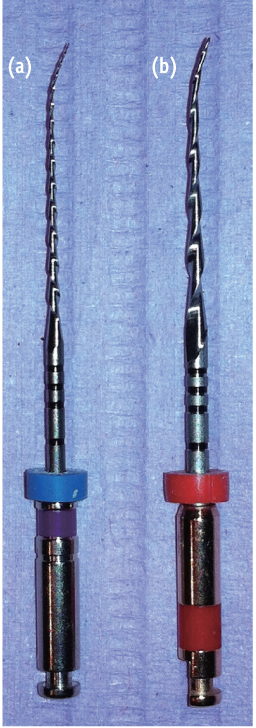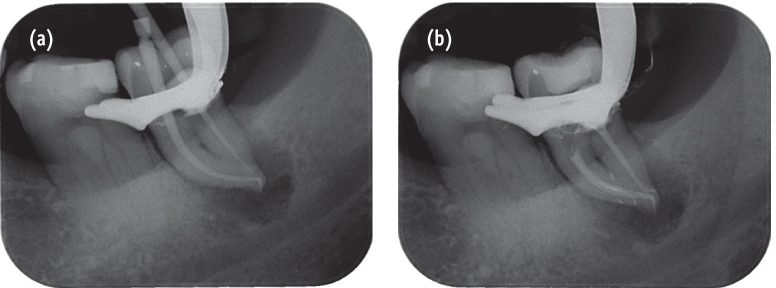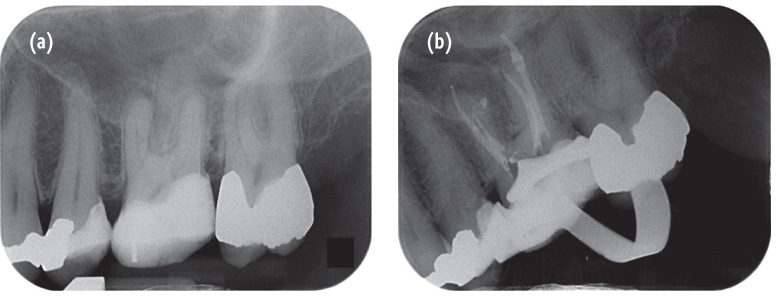Restor Dent Endod.
2015 Feb;40(1):85-90. 10.5395/rde.2015.40.1.85.
Canal preparation with nickel-titanium or stainless steel instruments without the risk of instrument fracture: preliminary observations
- Affiliations
-
- 1Private practice, Toronto, ON, Canada. ghassanyared@gmail.com
- KMID: 2316929
- DOI: http://doi.org/10.5395/rde.2015.40.1.85
Abstract
- This report introduces a novel technique that allows a safe and predictable canal negotiation, creation of a glide path and canal preparation with reciprocating nickel-titanium or stainless steel engine-driven instruments in canals where the use of rotary and the newly developed reciprocating instruments is contraindicated. In this novel technique, the instruments are used in reciprocating motion with very small angles. Hand files are not used regardless of the complexity of the canal anatomy. It also allows achieving predictable results in canal negotiation and glide path creation in challenging canals without the risk of instrument fracture.
Keyword
Figure
Reference
-
1. Alapati SB, Brantley WA, Svec TA, Powers JM, Mitchell JC. Scanning electron microscope observations of new and used nickel-titanium rotary files. J Endod. 2003; 29:667–669.
Article2. American Association of Endodontists. Endodontics: Colleagues for excellence newsletter. Rotary instrumentation: an endodontic perspective. 2008. Winter. 1–8. updated 2014 Nov 2. Available from: http://www.aae.org/colleagues.3. Buchanan LS. Managing severe canal curvatures and apical impediments: an endodontic case study. Dent Today. 2005; 24:124–131.4. Berutti E, Cantatore G, Castellucci A, Chiandussi G, Pera F, Migliaretti G, Pasqualini D. Use of nickel-titanium rotary PathFile to create the glide path: comparison with manual preflaring in simulated root canals. J Endod. 2009; 35:408–412.
Article5. De-Deus G, Arruda TE, Souza EM, Neves A, Magalhães K, Thuanne E, Fidel RA. The ability of the Reciproc R25 instrument to reach the full root canal working length without a glide path. Int Endod J. 2013; 46:993–998.
Article6. Inan U, Gonulo N. Deformation and fracture of Mtwo rotary nickel-titanium instruments after clinical use. J Endod. 2009; 35:1396–1399.
Article7. Kinsey B, Mounce R. Safe and efficient use of the M4 safety handpiece in endodontics. Roots. 2008; 4(2):36–40.8. Pruett JP, Clement DJ, Carnes DL Jr. Cyclic fatigue testing of nickel-titanium endodontic instruments. J Endod. 1997; 23:77–85.
Article9. Best S, Watson P, Pillar R, Kulkarni GG, Yared G. Torsional fatigue and endurance limit of a size 30.06 ProFile rotary instrument. Int Endod J. 2004; 37:370–373.
Article10. Saber Sel D, Abu El Sadat SM. Effect of altering the reciprocation range on the fatigue life and the shaping ability of WaveOne nickel-titanium instruments. J Endod. 2013; 39:685–688.11. Madani ZS, Haddadi A, Haghanifar S, Bijani A. Cone-beam computed tomography for evaluation of apical transportation in root canals prepared by two rotary systems. Iran Endod J. 2014; 9:109–112.12. Wu MK, R'oris A, Barkis D, Wesselink PR. Prevalence and extent of long oval canals in the apical third. Oral Surg Oral Med Oral Pathol Oral Radiol Endod. 2000; 89:739–743.
Article13. Suresh S. Fatigue of materials. 2nd ed. Cambridge: Cambridge University Press;1998. p. 59.14. Gambarini G, Plotino G, Sannino G, Grande NM, Giansiracusa A, Piasecki L, da Silva Neto UX, Al-Sudani D, Testarelli L. Cyclic fatigue of instruments for endodontic glide path. Odontology. 2013. 11. 07. [Epub ahead of print].
Article15. Yared G. Continuing education: Canal preparation with only one file used in reciprocation. updated 2014 Jul 29. Available from: http://endodonticcourses.com/literature.16. Jafarzadeh H, Abbott PV. Ledge formation: review of a great challenge in endodontics. J Endod. 2007; 33:1155–1162.
Article
- Full Text Links
- Actions
-
Cited
- CITED
-
- Close
- Share
- Similar articles
-
- Retrieval of a separated nickel-titanium instrument using a modified 18-guage needle and cyanoacrylate glue: a case report
- Evaluation of apical canal shapes produced sequentially during instrumentation with stainless steel hand and Ni-Ti rotary instruments using Micro-computed tomography
- The instrument-centering ability of four Nickel-Titanium instruments in simulated curved root canals
- Cyclic fatigue resistance of the WaveOne Gold Glider, ProGlider, and the One G glide path instruments in double-curvature canals
- Mechanical properties of nickel titanium and steel alloys under stress- strain test






